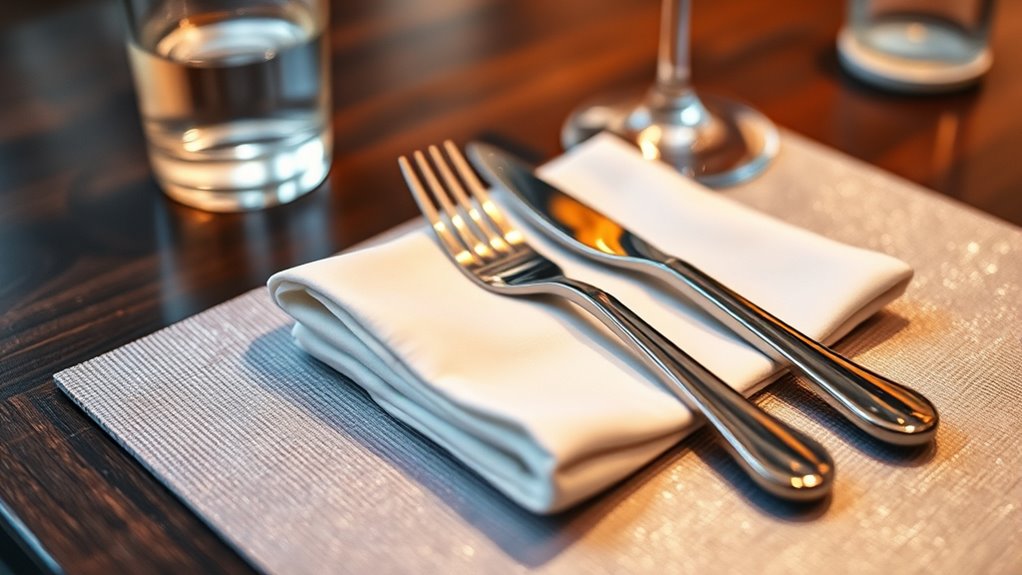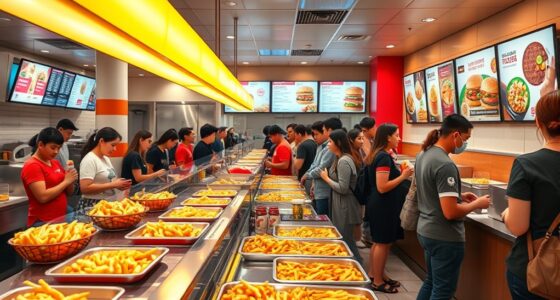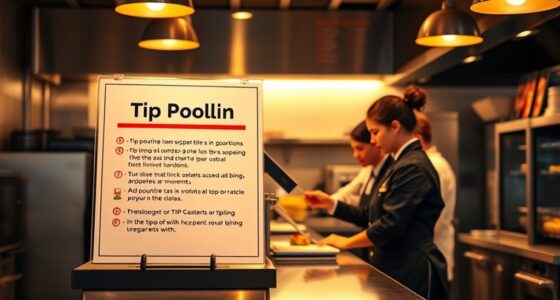A cover in restaurant metrics refers to each individual guest you serve during a specific period, usually counted as one guest per meal or seat. It helps you understand your customer flow and overall popularity. Tracking covers shows how many diners enjoy your food, how busy your restaurant gets, and when peak hours occur. If you’re curious about how to boost your customer count and improve operations, there’s more to discover below.
Key Takeaways
- A cover represents each individual guest served during a specific period.
- It is typically counted as one guest per meal or seat.
- Tracking covers helps measure restaurant popularity and customer flow.
- Higher covers indicate increased guest turnout and revenue potential.
- Optimizing covers involves improving table turnover and operational efficiency.

Understanding the concept of “cover” in restaurant metrics is essential for managing your business effectively. A cover represents each individual guest served during a specific period, typically counted as one guest per meal or seat. When you track covers, you’re essentially measuring how many people sit down and enjoy a meal at your restaurant. This metric helps you gauge the overall guest count and understand customer flow. If you notice an increase in covers, it likely means more guests are choosing your restaurant, which can be a sign of growing popularity or successful marketing efforts. Conversely, a decline might indicate issues with your menu, service, or local competition.
A cover counts each guest served, helping you measure customer flow and restaurant popularity.
Guest count, closely tied to covers, is a vital indicator of your restaurant’s performance. It directly influences your revenue and helps you analyze trends over time. By monitoring the guest count, you can identify peak hours and plan staffing accordingly to ensure excellent service without overstaffing. This improves efficiency and customer satisfaction. For example, if you see your covers spike during weekend evenings, you’ll know to allocate more staff during those times. On the other hand, if weekday lunches have low covers, you might consider promotional strategies to boost traffic during those hours.
Table turnover is another critical aspect linked to covers. It refers to how many times a table is occupied and cleared within a specific timeframe. Higher table turnover means more guests are seated and served in a shorter period, which increases your overall covers. For instance, if your restaurant has a table turnover rate of three per table during dinner service, each table is hosting three different guest groups throughout the evening. Improving table turnover can substantially boost your revenue without expanding your space. You might achieve this through efficient service, streamlined ordering processes, or better table management.
Understanding the relationship between guest count, table turnover, and covers enables you to optimize your restaurant’s operations. If your goal is to increase total covers, focusing on faster table turnover during peak hours can be effective. Conversely, if you want to improve guest experience, balancing quick turnover with attentive service is key. Tracking these metrics regularly helps you identify patterns, make informed decisions, and set realistic goals. Ultimately, a clear grasp of what covers represent in your restaurant allows you to fine-tune your strategies, maximize revenue, and ensure your guests leave satisfied.
Additionally, leveraging Powerful persuasive words in your marketing can attract more guests and increase covers.
Frequently Asked Questions
How Is a “Cover” Different From a “Seat” in Restaurant Metrics?
A “cover” counts each guest served during a meal service, while a “seat” refers to a specific place at a table. During busy times, your table turnover rate increases, meaning more covers are served from the same number of seats. Basically, covers measure your total guest count, whereas seats focus on the physical capacity of your restaurant. Both metrics help you analyze efficiency and optimize your service.
How Do Covers Impact Restaurant Profitability Calculations?
Think of covers as your restaurant’s secret weapon, much like a magician’s trick. They directly influence profitability by showing guest volume and revenue per cover. When you increase covers, you boost total revenue, but only if revenue per cover stays strong. Monitoring covers helps you identify busy times and optimize staff, ensuring you maximize profit without sacrificing service quality. It’s your key to balancing guest flow and earnings.
Can the Number of Covers Indicate Customer Satisfaction Levels?
The number of covers can hint at customer satisfaction levels, but it isn’t definitive on its own. If you gather positive customer feedback and maintain high service quality, higher covers usually indicate happy guests. Conversely, declining covers might suggest issues. Keep an eye on reviews and service standards, as these factors influence repeat visits and overall satisfaction, making the cover count a useful, but not sole, indicator.
What Tools Are Best for Tracking Cover Counts?
You should use digital tools like POS systems and reservation software to track cover counts accurately and efficiently. These tools automatically record each guest, saving you time and reducing errors. While manual counting can work for smaller venues, digital tools offer real-time data and detailed insights that help you monitor customer flow and optimize staffing. Combining both methods guarantees you stay on top of your restaurant’s performance.
How Do Covers Influence Staffing and Inventory Decisions?
Did you know that a 10% increase in covers can boost revenue by up to 15%? Covers directly influence staffing and inventory decisions since higher cover counts mean you need more staff to ensure a positive guest experience. You can optimize marketing strategies by analyzing cover trends, ensuring you’re prepared for busy times. This way, you maintain quality service and efficient inventory management, ultimately enhancing guest satisfaction and profitability.
Conclusion
So, next time you’re counting covers, remember—it’s not just about the numbers. Sure, a high cover count might seem like a win, but it could also mean you’re sacrificing quality for quantity. Ironically, chasing more covers might just leave your restaurant less memorable. After all, in the end, isn’t it better to focus on making each cover count? Because sometimes, less truly is more—at least, in the world of restaurant metrics.









